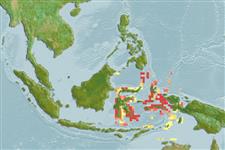>
Ovalentaria/misc (Various families in series Ovalentaria) >
Pomacentridae (Damselfishes) > Pomacentrinae
Etymology: Neoglyphidodon: Greek, para = the side of + Greek, glyphis = carved + Greek, odous = teeth.
Eponymy: Norbert J Cross is an Honorary Associate of the Western Australian Museum (Perth), where Allen works, and with whom he has co-authored papers such as: Description of Five New Rainbowfishes (Melanotaeniidae) From New Guinea (1980) and the book: [...] (Ref. 128868), visit book page.
Environment: milieu / climate zone / rango de profundidad / distribution range
Ecología
marino asociado a arrecife; no migratorio; rango de profundidad 1 - 12 m (Ref. 90102). Tropical; 5°N - 11°S, 119°E - 135°E
Western Central Pacific: known only from Sulawesi and the Moluccas.
Tamaño / Peso / Age
Madurez: Lm ? range ? - ? cm
Max length : 10.0 cm SL macho / no sexado; (Ref. 7247)
Short description
Claves de identificación | Morfología | Morfometría
Espinas dorsales (total) : 13; Radios blandos dorsales (total) : 14 - 16; Espinas anales: 2; Radios blandos anales: 13 - 14.
Body shape (shape guide): short and / or deep; Cross section: compressed.
Adults inhabit shallow gutters of rocky areas or coral reefs of protected bays and lagoons. Solitary and shy (Ref. 9710). Often swimming near the surface (Ref. 48636). Oviparous, distinct pairing during breeding (Ref. 205). Eggs are demersal and adhere to the substrate (Ref. 205). Males guard and aerate the eggs (Ref. 205). Diurnal species (Ref. 113699).
Life cycle and mating behavior
Madurez | Reproducción | Puesta | Huevos | Fecundidad | Larva
Oviparous, distinct pairing during breeding (Ref. 205). Eggs are demersal and adhere to the substrate (Ref. 205). Males guard and aerate the eggs (Ref. 205).
Allen, G.R., 1991. Damselfishes of the world. Mergus Publishers, Melle, Germany. 271 p. (Ref. 7247)
IUCN Red List Status (Ref. 130435: Version 2025-1)
Threat to humans
Harmless
Human uses
Herramientas
Special reports
Download XML
Fuentes de Internet
Estimates based on models
Preferred temperature (Referencia
123201): 28.4 - 29.2, mean 28.8 °C (based on 140 cells).
Phylogenetic diversity index (Referencia
82804): PD
50 = 0.5020 [Uniqueness, from 0.5 = low to 2.0 = high].
Bayesian length-weight: a=0.02344 (0.01134 - 0.04848), b=2.98 (2.80 - 3.16), in cm total length, based on LWR estimates for this (Sub)family-body shape (Ref.
93245).
Nivel trófico (Referencia
69278): 2.8 ±0.3 se; based on size and trophs of closest relatives
Resiliencia (Referencia
120179): Alto, población duplicada en un tiempo mínimo inferior a 15 meses (Preliminary K or Fecundity.).
Fishing Vulnerability (Ref.
59153): Low vulnerability (10 of 100).
🛈
Nutrients (Ref.
124155): Calcium = 113 [56, 183] mg/100g; Iron = 0.725 [0.421, 1.212] mg/100g; Protein = 18.5 [17.3, 19.6] %; Omega3 = 0.115 [0.067, 0.193] g/100g; Selenium = 18.3 [10.1, 36.3] μg/100g; VitaminA = 113 [33, 367] μg/100g; Zinc = 1.6 [1.1, 2.3] mg/100g (wet weight);
